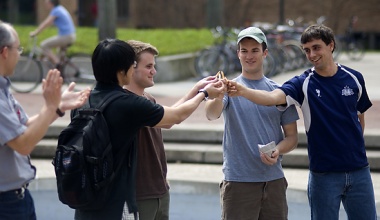How it Started

For many years Associate Professor of Chemistry Doug Schirch has had his students in Organic Chemistry laboratories synthesize biodiesel. This practice began in the 1990s when he taught in Nicaragua where Dr. Nikolaus Foidl, an early proponent of biodiesel, helped him get started.
In 2007, after moving to GC, he asked his students if any were interested in writing a proposal for a project that would convert all the campus’s used cooking oil into biodiesel. Later that year GC President Jim Brenneman made the college a charter signatory to the American College & University Presidents Climate Commitment, pledging the college to reduce its global warming emissions and support efforts to help stablize the earth’s climate. As part of that pledge the president convened a Ecological Stewardship Committee to evaluate proposals, and its first submission came from four Organic Chemistry students: Nate Herr, Mitch Yoder, Neil Detweiler and Sae Chan Lee.
The four students, all biochemistry majors, wrote an extensive feasability study that showed the biodiesel could be produced at a cost that would pay for material inputs, including chemicals and electricity, as well as the hourly wages for student workers that would run the conversion process. The approximately $6,000 material costs for the biodiesel reactor were paid by the college, and the four students donated hundreds of hours of free labor for its assembly. The reactor, which uses converted water heaters and many common plumbing supplies, was built according to instructions published in the book Biodiesel: Basics and Beyond, by William Kemp. The reactor was built in the spring semester of 2008 and produced its first batch of biodiesel in April of that year.




